IDP Stage
Introduction
Presently this Feature is behind the Feature Flag IDP_ENABLE_STAGE, please contact with Harness Support to enable it in your Account.
The self-service flow in IDP is powered by the Harness Pipelines. A stage is a part of a pipeline that contains the logic to perform a major segment of a larger workflow defined in a pipeline. Stages are often based on the different workflow milestones, such as building, approving, and delivering.
The process of adding a stage to a pipeline is the same for all Harness modules. When you add a stage to a pipeline, you select the stage type, such as Developer Portal for IDP or Build for CI or Deploy for CD. The available stage settings are determined by the stage type, and, if applicable, the module associated with the selected stage type.
This functionality is limited to the modules and settings that you have access to.
How to Add the Developer Portal Stage
- Present Nav
- New Nav
- Go to Projects and Select your project and create a new pipeline.
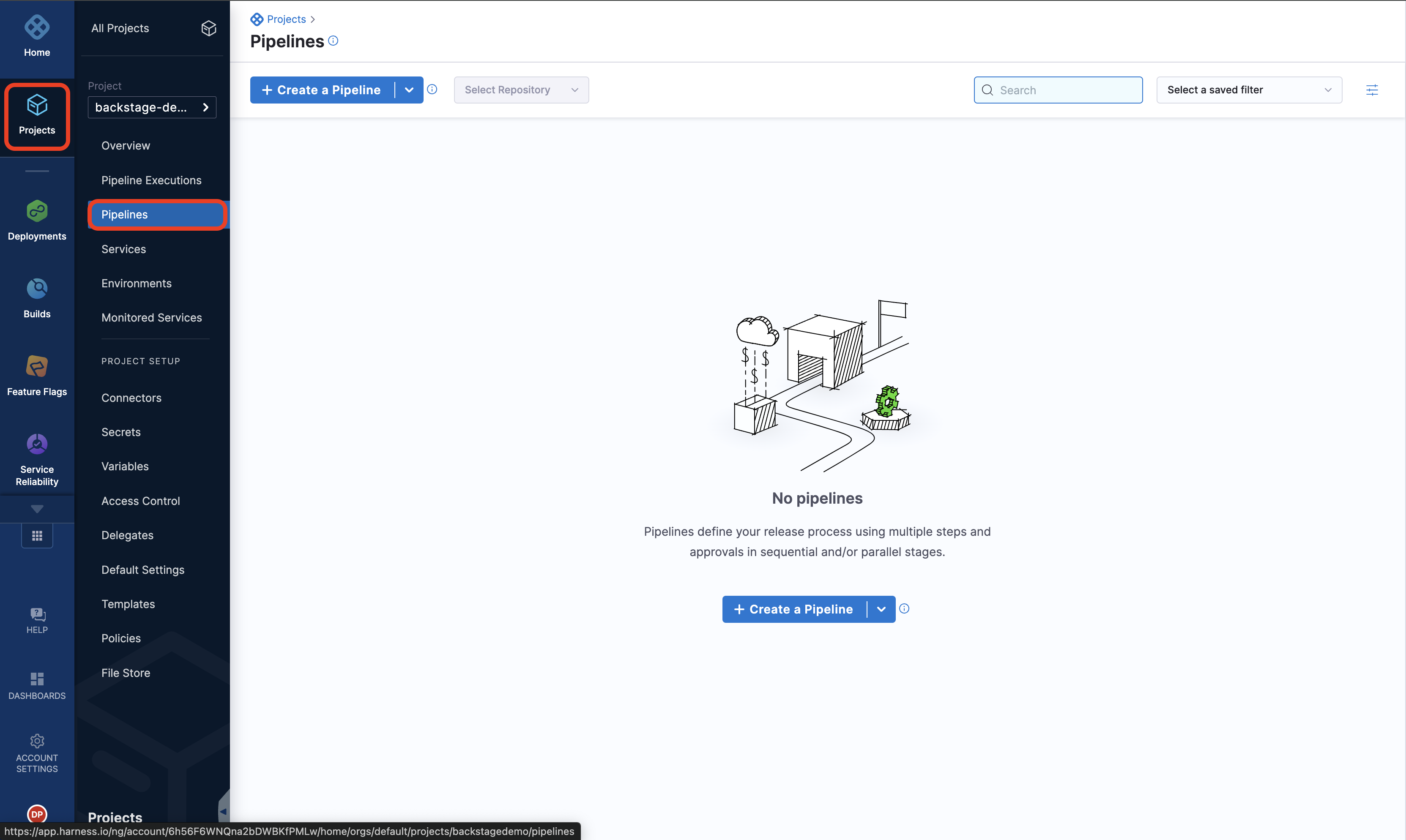
- Go to Pipelines under Admin from side nav and Create a Pipeline.
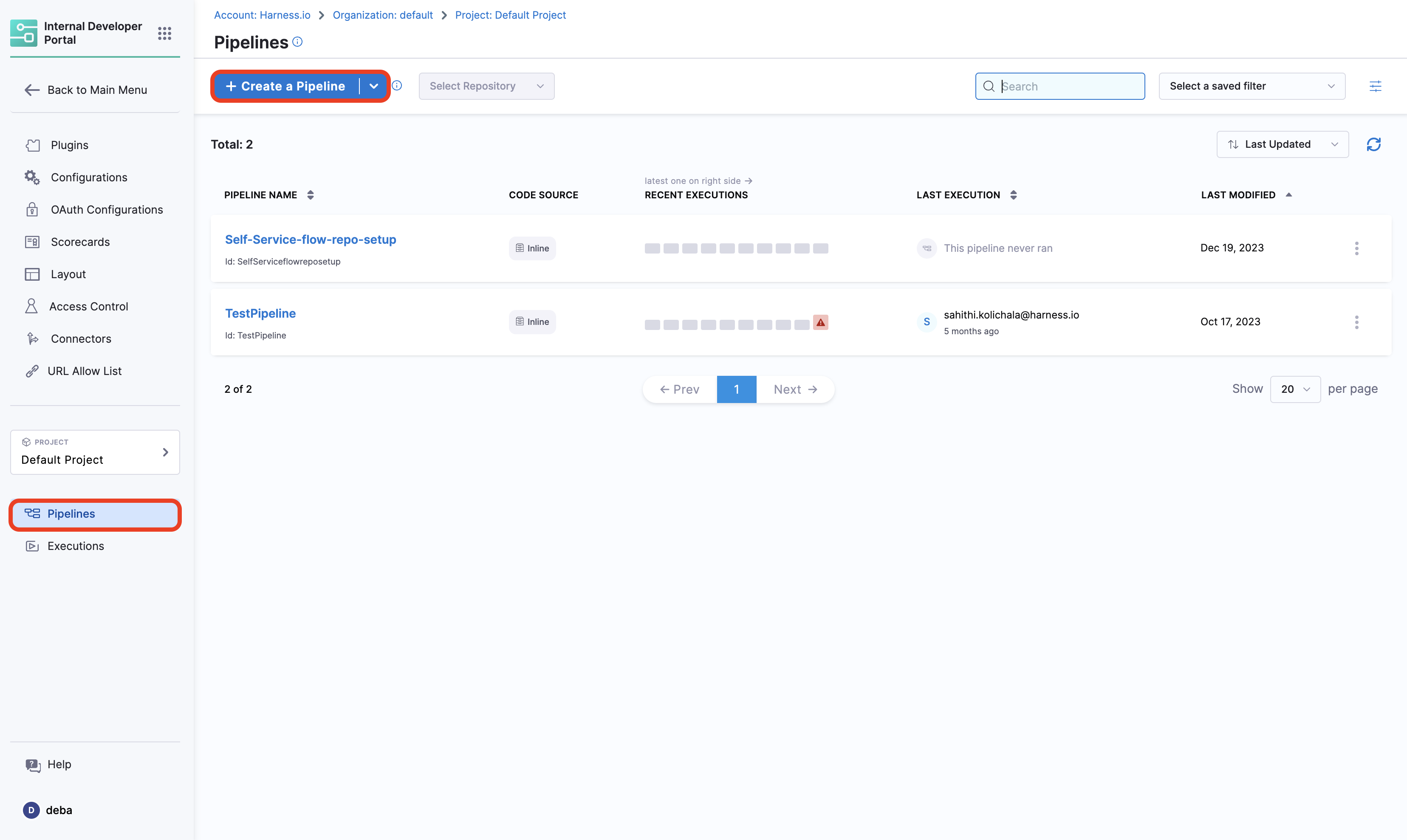
- Add a Name for your Pipeline and select Inline as pipeline storage options.
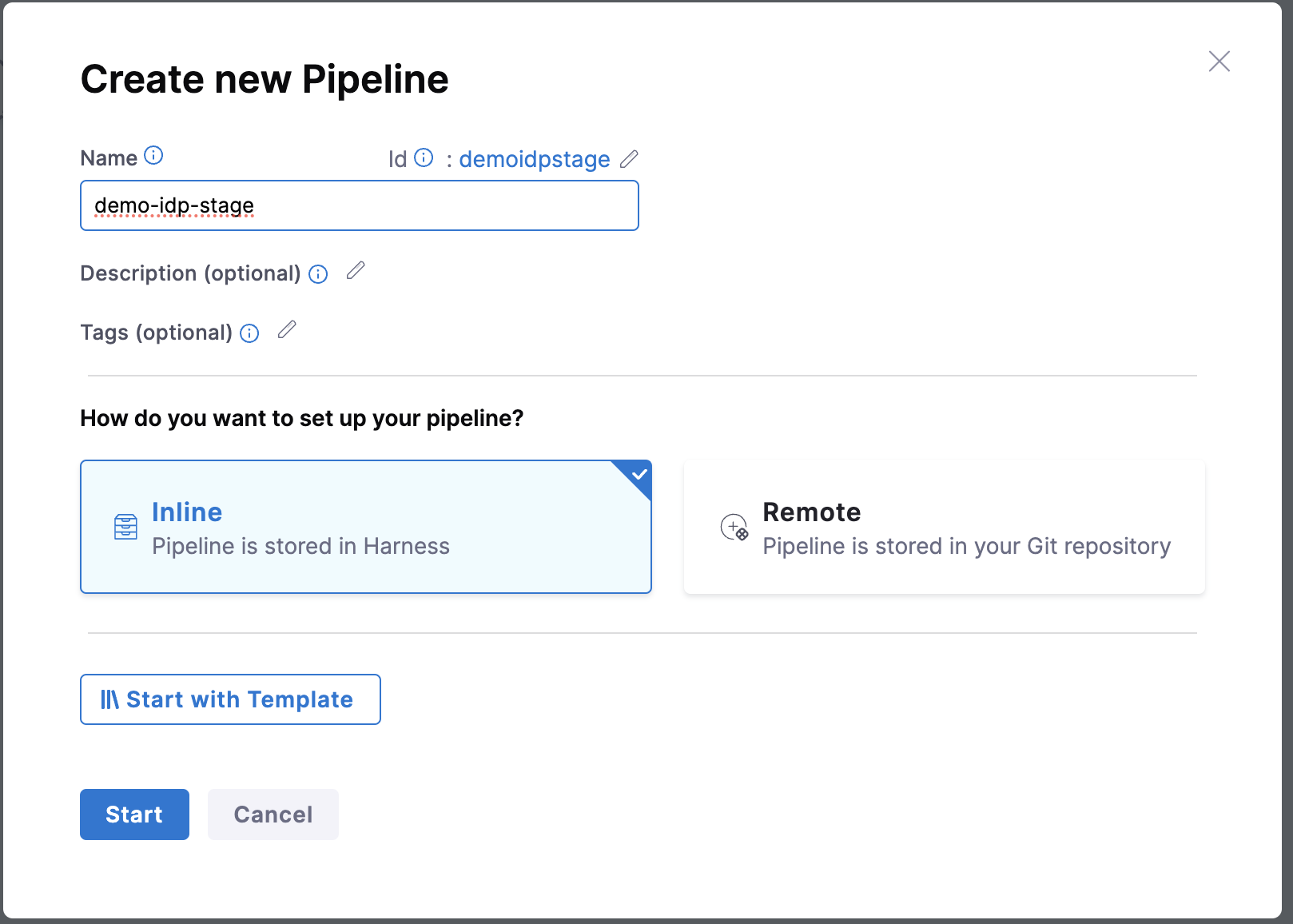
- Now Select Stage Type as Developer Portal and add a name for your stage to Set Up Stage.

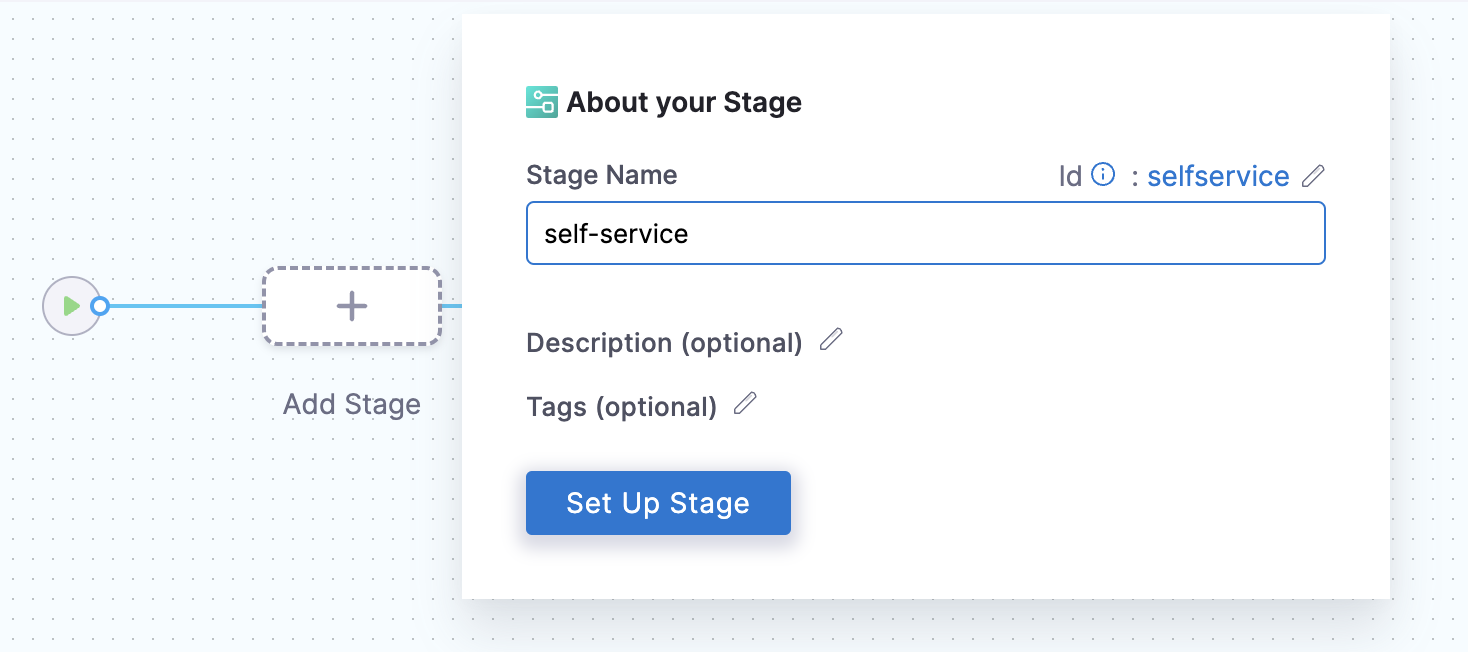
Infrastructure
- Under Infrastructure tab, Harness recommends Harness Cloud, but you can also use a Kubernetes cluster, local runner or self-managed AWS/GCP/Azure VM build infrastructure.

Pipeline Variables
-
Before adding the execution steps we need to create some pipeline variables with runtime inputs which we will be using as expression inputs in various steps under execution.
-
To add pipeline variables go to the right nav of your pag and select Variables icon.
-
Under Custom Variables select +Add Variable.
-
Add a name to the variable and select the input type as Runtime.
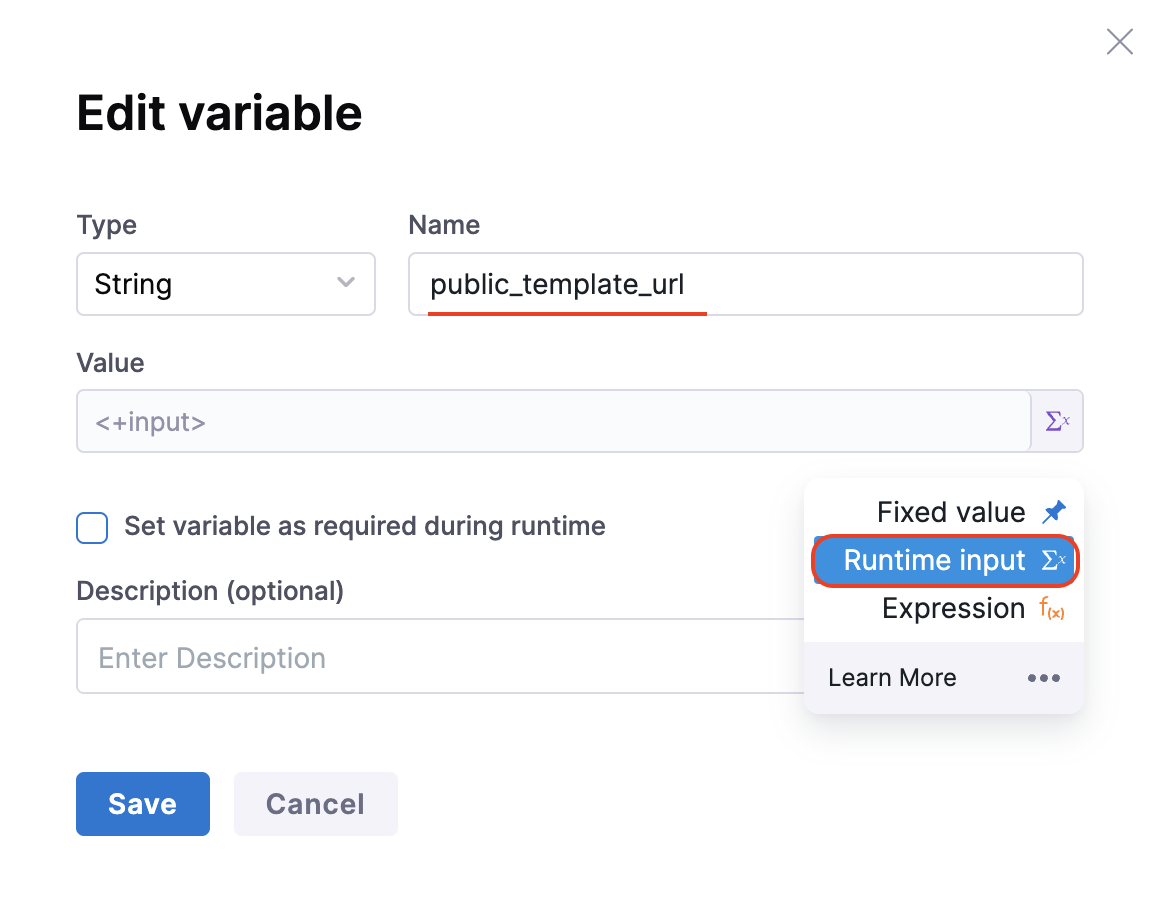
To use the pipeline variable select the input type as Expressions and follow the JEXL format to add the variable.
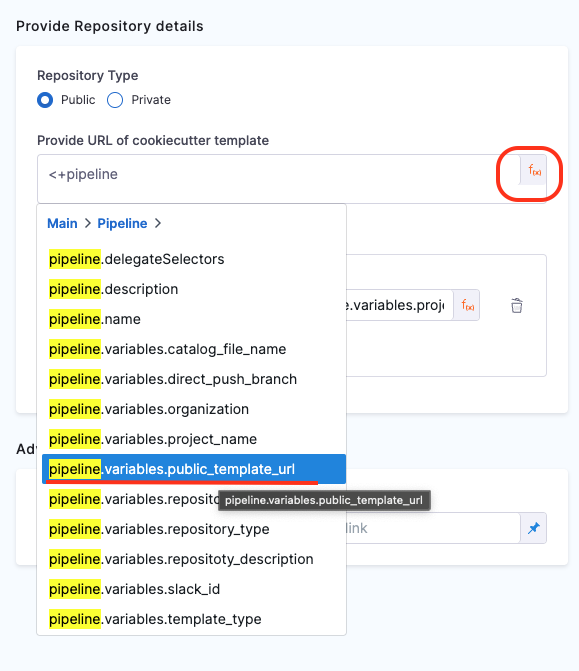
Execution Steps
- Now add the steps under the Execution Tab. The following is the list of suggested steps to be used in the execution.
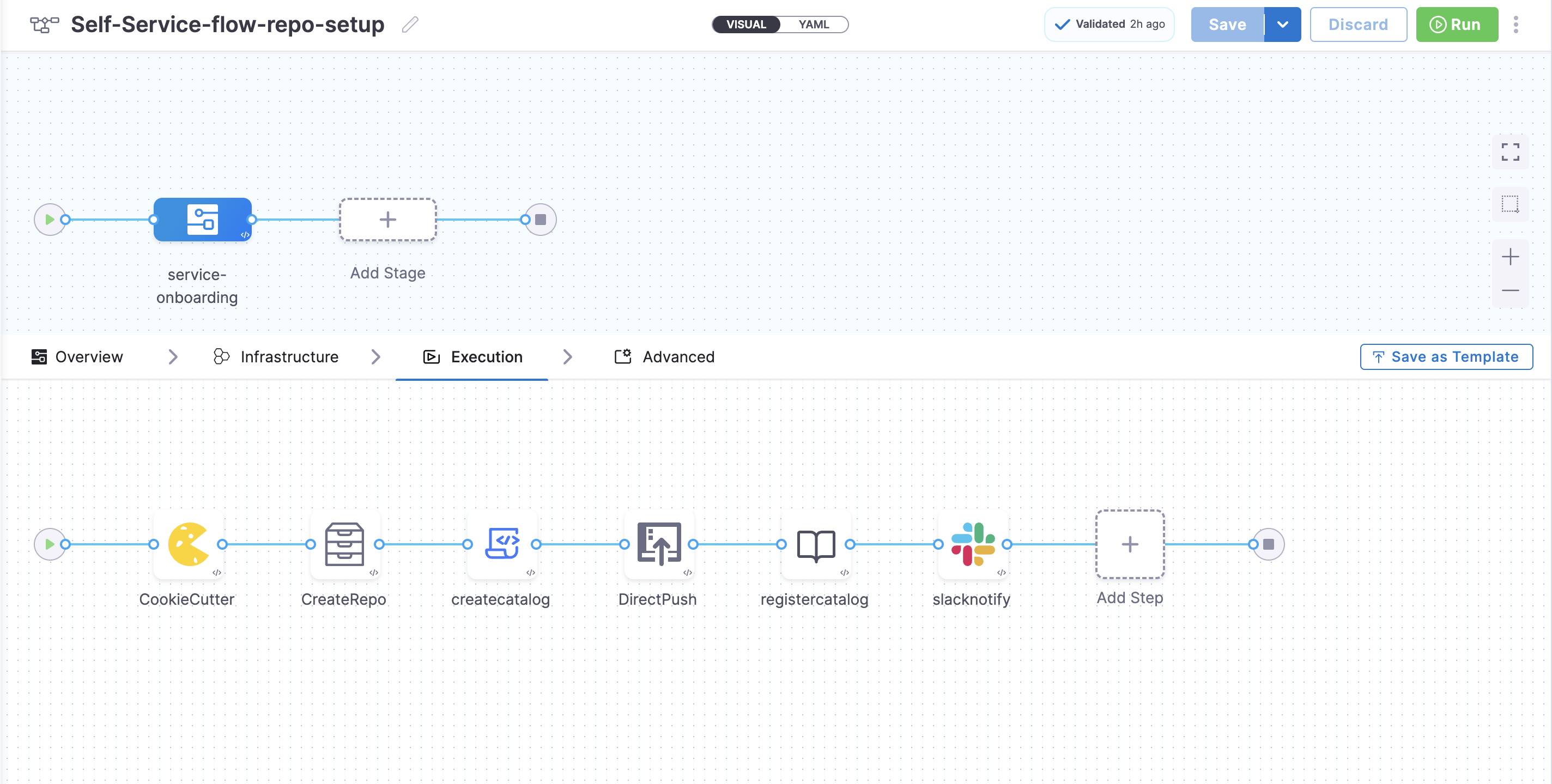
1. Add the Git Clone step (Ignore this step if your repository containing cookiecutter template is public)
Add a Git Clone step to clone a repository into the Developer Portal stage's workspace.
By cloning the repository, you gain access to the necessary code, scripts, or configurations, enabling you to perform various actions.
The Git Clone step uses a containerized step group. For more information, go to Containerize step groups.
- Pipeline Studio
- YAML
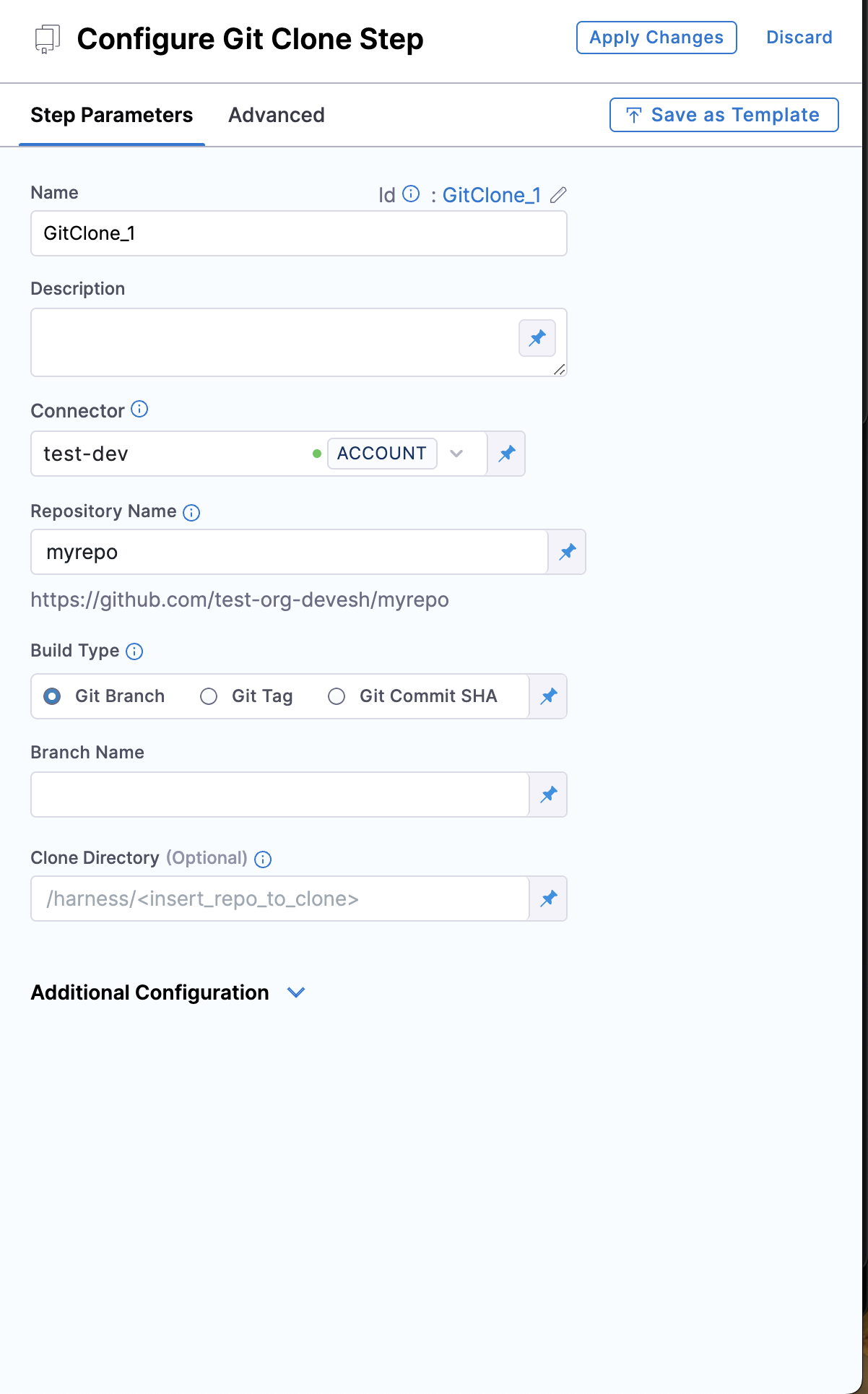
- In your Developer Portal stage, in Execution, select Add Step.
- Select Git Clone.
- Configure the steps using the settings described below.
- step:
type: GitClone
name: GitClone_1
identifier: GitClone_1
spec:
connectorRef: account.GitConnectorBzGN8G1COj
repoName: myrepo
build:
type: branch
spec:
branch: main
Select Git Provider
Select the Git Provider as Third-party Git Provider in case you don't have your code in Harness Code Repository
Connector
Presently for Connectors the connection type ssh is not supported and for credentials only Username and Password type is supported.
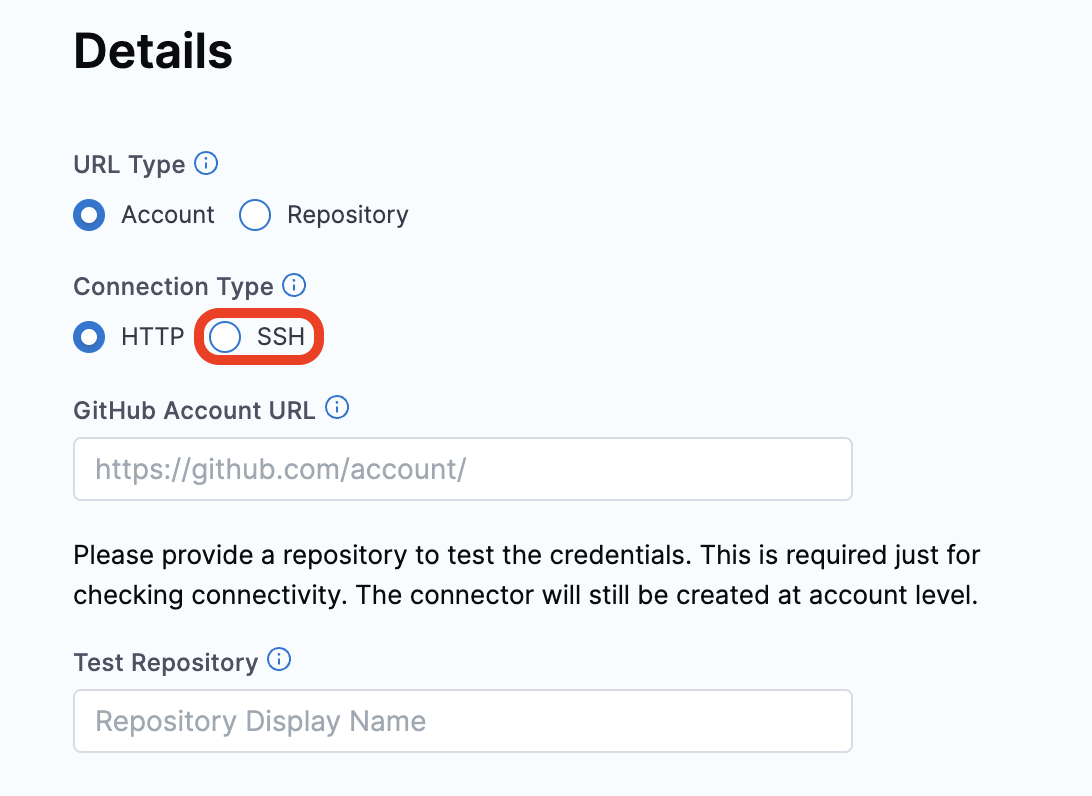

Select a connector for the source control provider hosting the code repository that you want the step to clone.
The following topics provide more information about creating code repo connectors:
- Azure Repos: Connect to Azure Repos
- Bitbucket: Bitbucket connector settings reference
- GitHub: GitHub connector settings reference
- GitLab: GitLab Connector Settings reference
- Other Git providers:
Repository Name
If the connector's URL Type is Repository, then Repository Name is automatically populated based on the repository defined in the connector's configuration.
If the connector's URL Type is Account, then you must specify the name of the code repository that you want to clone into the stage workspace.
Build Type, Branch Name, and Tag Name
For Build Type, select Git Branch if you want the step to clone code from a specific branch within the repository, or select Git Tag if you want the step to clone code from a specific commit tag. Based on your selection, specify a Branch Name or Tag Name.
You can use fixed values, runtime input, or variable expressions for the branch and tag names. For example, you can enter <+input> for the branch or tag name to supply a branch or tag name at runtime.
Clone directory
An optional target path in the stage workspace where you want to clone the repo.
Depth
The number of commits to fetch when the step clones the repo.
The default depth is 0, which fetches all commits from the relevant branch.
For more information, go to the git clone documentation.
2. Cookiecutter
Cookiecutter step is used to take inputs for the cookiecutter template.
In the example provided for this step we have used pipeline variables as input for many fields, make sure you have the corresponding pipeline variable created with proper value as described under pipeline variables.
- Pipeline Studio
- YAML

Repository Type
Select the repository type in which your template is stored, which could be public or private git repository.
In case it's Private make sure you have added the gitclone step and the path for template should be the Clone Directory added in gitclone step
In case of public templates you just need to add the public URL of the template path stored in your git provider. eg https://github.com/devesh-harness/test-cookicutter
Path for Template
First select the type of the input it could be a Fixed Value, Runtime input or Expression
In case of Fixed Value provide the absolute value of template URL, for eg. https://github.com/devesh-harness/test-cookicutter
In case of Runtime Input provide the absolute value of the template URL after you run the pipeline.
In case of Expression provide the pipeline variable in JEXL format which takes the template URL as an input, this is widely used while implementing the self service flow.
Configure Template
Provide the input required the template in terms of key value pairs in this step.
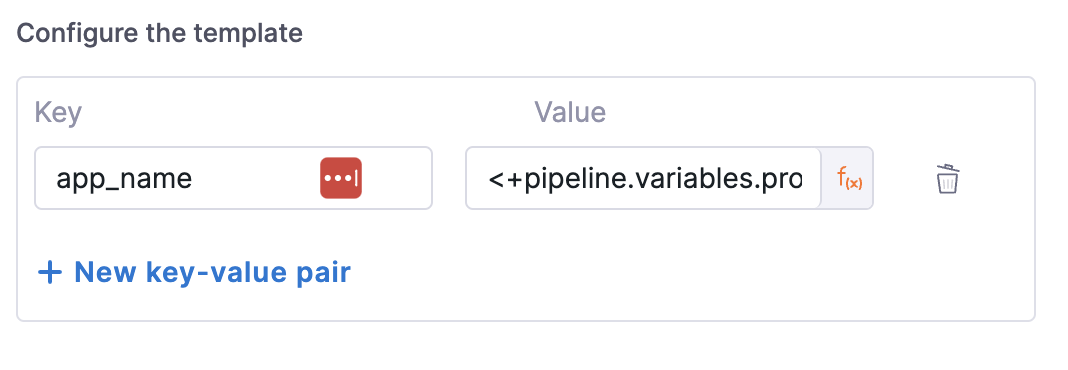
- step:
type: CookieCutter
name: CookieCutter
identifier: idpcookiecutter
spec:
templateType: public
publicTemplateUrl: <+pipeline.variables.public_template_url>
cookieCutterVariables:
app_name: <+pipeline.variables.project_name>
3. Create Repo
This step is to create the repository in your git provider which will be later used to add the service/app created using cookiecutter step along with the catalog which will be created in the Create Catalog step.
In the example provided for this step we have used pipeline variables as input for many fields, make sure you have the corresponding pipeline variable created with proper value as described under pipeline variables.
The git connector used under Connectors Page in IDP Admin should have fetch access to the repository getting created in this step.
- Pipeline Studio
- YAML
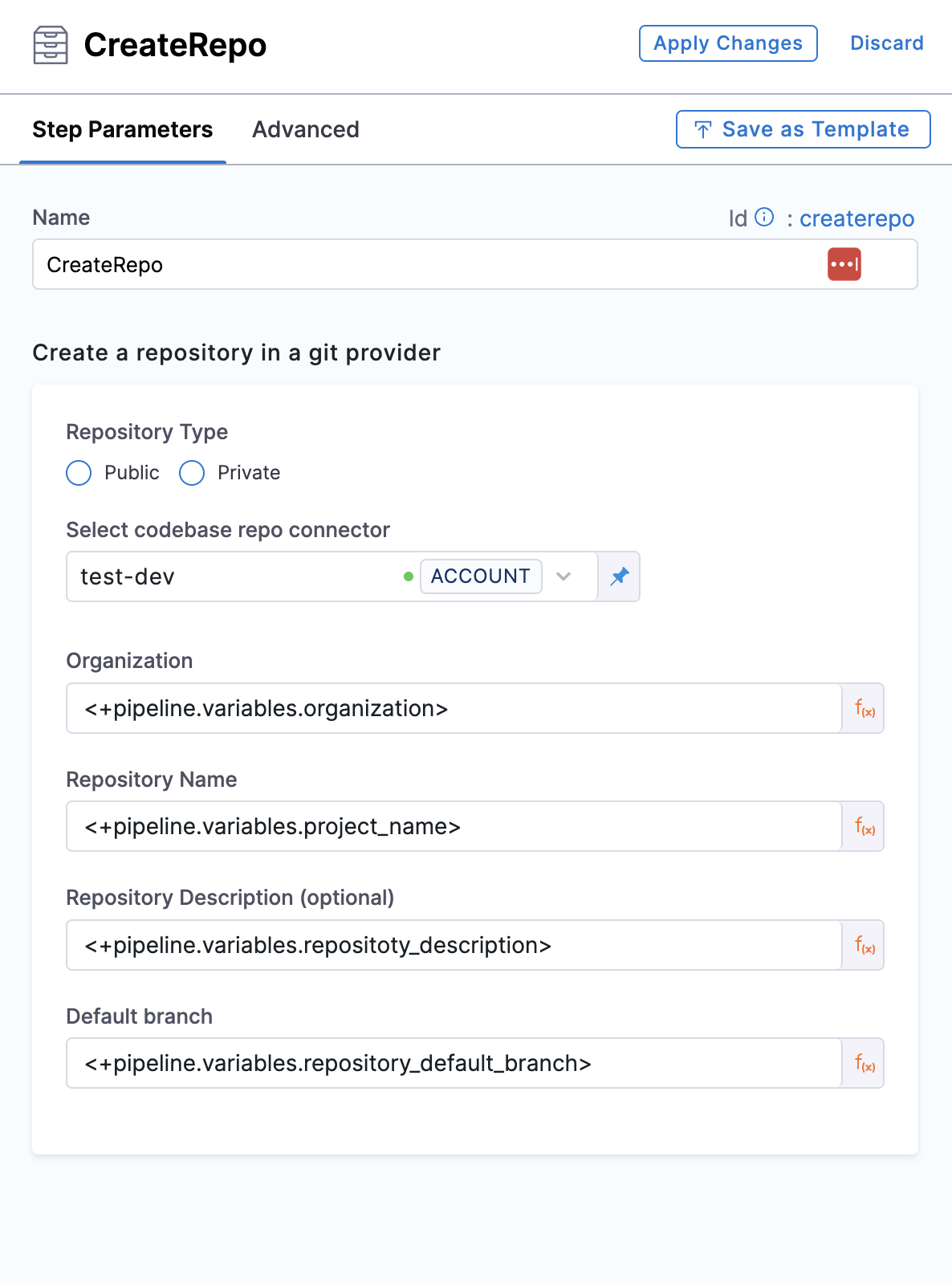
Repository Type
Select the repository type you want to create, which could be public or private.
Connector
Presently for Connectors the connection type ssh is not supported and for credentials only Username and Password type is supported.


Select a connector for the git provider that will host the code repository.
The following topics provide more information about creating code repo connectors:
- Azure Repos: Connect to Azure Repos
- Bitbucket: Bitbucket connector settings reference
- GitHub: GitHub connector settings reference
- GitLab: GitLab Connector Settings reference
- Other Git providers:
Org, Repo, Description, Default Branch
Add the org, repo name, Repo Description and Default branch for the repo you want to create.
- step:
type: CreateRepo
name: CreateRepo
identifier: createrepo
spec:
connectorRef: account.testdev
organization: <+pipeline.variables.organization>
repository: <+pipeline.variables.project_name>
repoType: <+pipeline.variables.repository_type>
description: <+pipeline.variables.repository_description>
defaultBranch: <+pipeline.variables.repository_default_branch>
Output
Following is the output variable of this step.
- repositoryUrl : The URL of the repository created eg;
https://github.com/org-name/repo-nameand this variable could be used in other steps in the pipeline by using this JEXL expression as a stage variable<+pipeline.stages.idp.spec.execution.steps.createrepo.output.outputVariables.repositoryUrl>
These output variable could be viewed under the output tab in
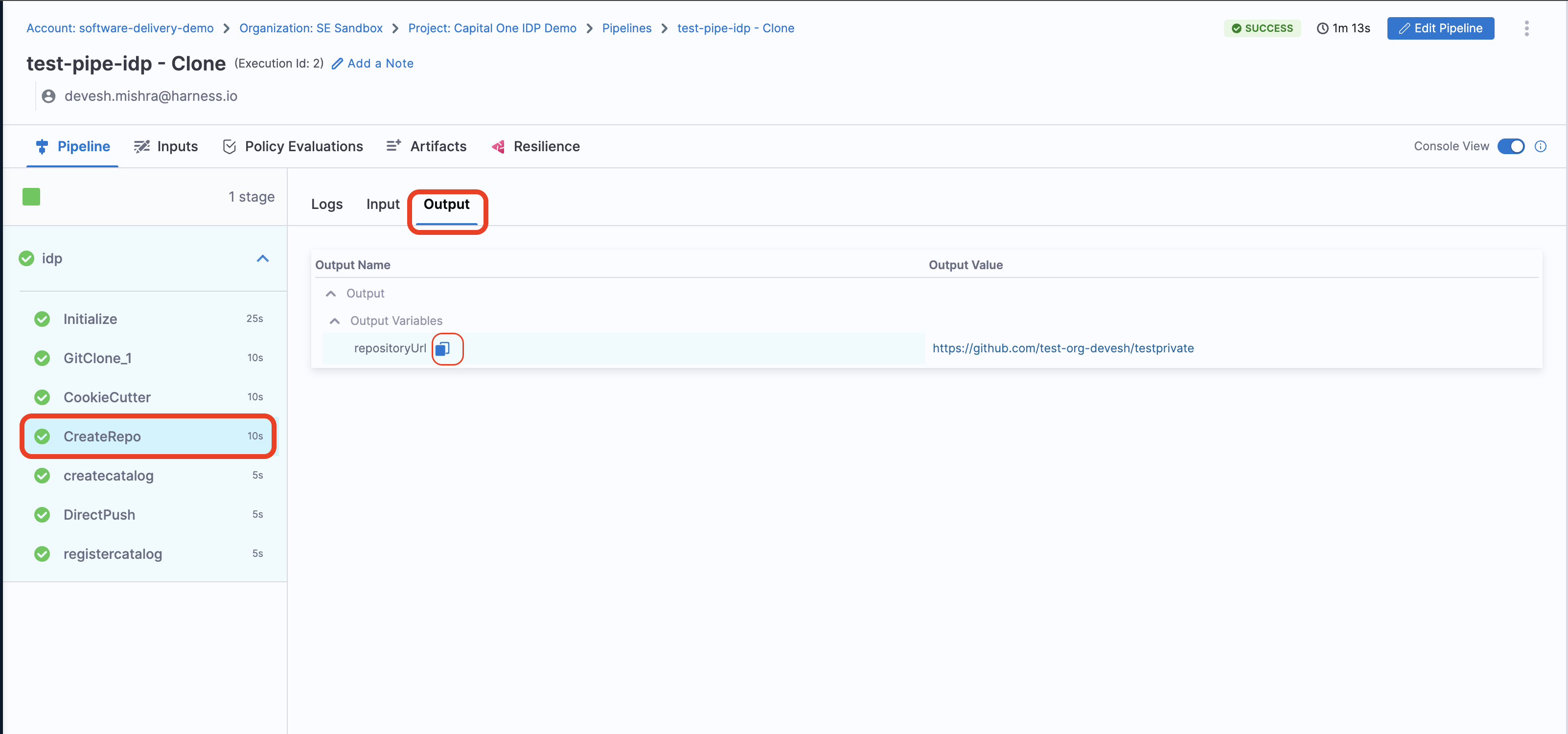
4. Create Catalog
This step is used to create the catalog-info.yaml/idp.yaml to be ued to register the software component we have created in previous step in our IDP catalog.
In the example provided for this step we have used pipeline variables as input for many fields, make sure you have the corresponding pipeline variable created with proper value as described under pipeline variables.
The git connector used under Connectors Page in IDP Admin should have fetch access to the repository the catalog-info.yaml is getting published to, for it to be registered in the catalog.
- Pipeline Studio
- YAML
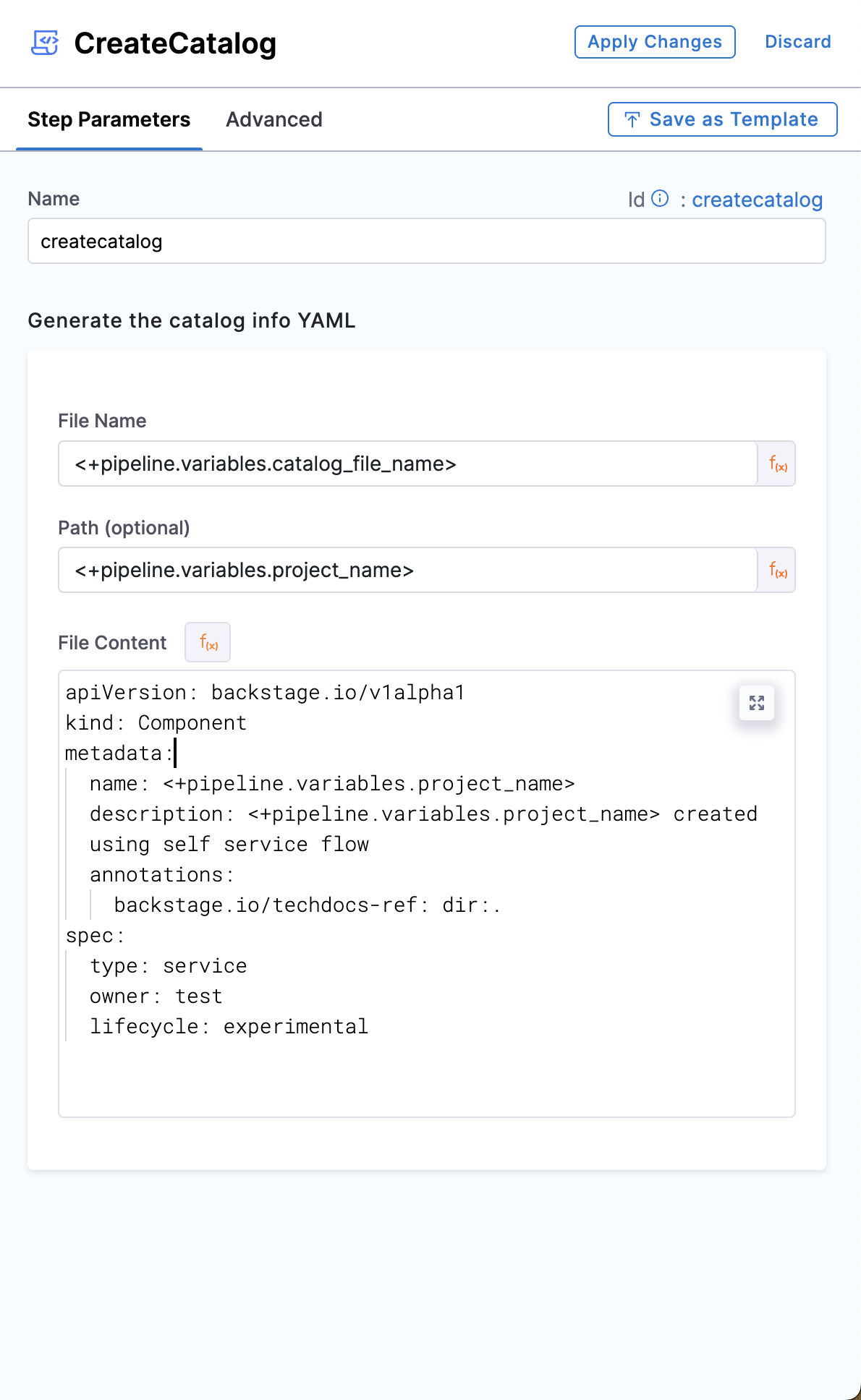
File Name, Path
Name the catalog-info.yaml followed by providing a path if you don't want to register in the root of the repo created in the Create Repo step.
File Content
Add the YAML content to be added in your catalog-info.yaml file, For eg.,
apiVersion: backstage.io/v1alpha1
kind: Component
metadata:
name: <+pipeline.variables.project_name>
description: <+pipeline.variables.project_name> created using self service flow
annotations:
backstage.io/techdocs-ref: dir:.
spec:
type: service
owner: test
lifecycle: experimental
- step:
type: CreateCatalog
name: createcatalog
identifier: createcatalog
spec:
fileName: <+pipeline.variables.catalog_file_name>
filePath: <+pipeline.variables.project_name>
fileContent: |-
apiVersion: backstage.io/v1alpha1
kind: Component
metadata:
name: <+pipeline.variables.project_name>
description: <+pipeline.variables.project_name> created using self service flow
annotations:
backstage.io/techdocs-ref: dir:.
spec:
type: service
owner: test
lifecycle: experimental
Output
Following is the output variable of this step.
- registeredCatalogUrl : The URL of the software component registered in the catalog of IDP eg;
https://app.harness.io/ng/account/**************/module/idp/catalog/default/component/component-nameand this variable could be used in other steps in the pipeline by using this JEXL expression as a stage variable<<+pipeline.stages.idp.spec.execution.steps.createcatalog.output.outputVariables.registeredCatalogUrl>>
These output variable could be viewed under the output tab in
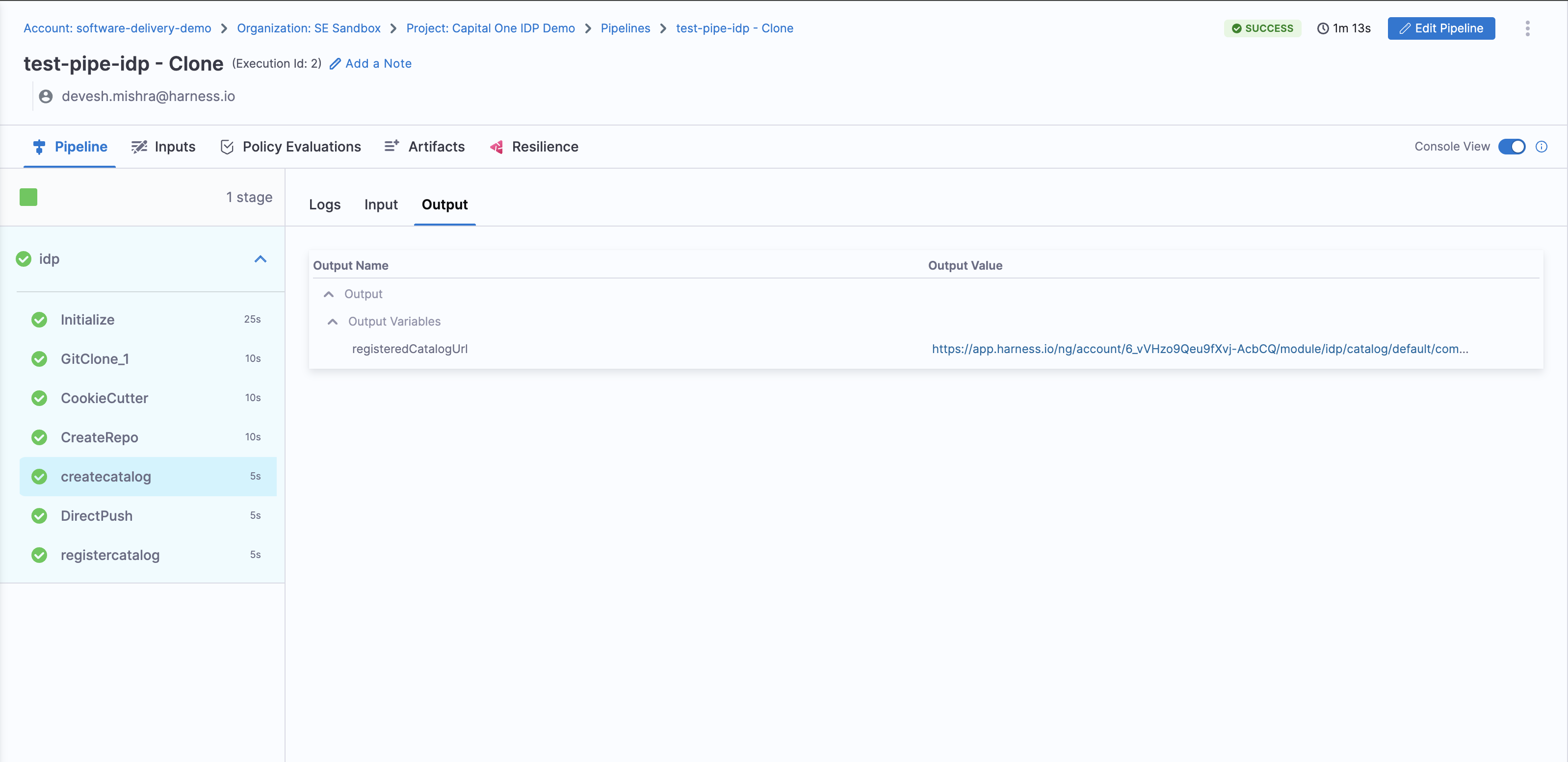
5. Direct Push
This step is used to push the service/application created using Cookiecutter step along with the catalog-info.yaml in the repo you created in previous step.
In the example provided for this step we have used pipeline variables as input for many fields, make sure you have the corresponding pipeline variable created with proper value as described under pipeline variables.
- Pipeline Studio
- YAML

Connector
Presently for Connectors the connection type ssh is not supported and for credentials only Username and Password type is supported.


Select a connector for the git provider where you want to push the code.
The following topics provide more information about creating code repo connectors:
- Azure Repos: Connect to Azure Repos
- Bitbucket: Bitbucket connector settings reference
- GitHub: GitHub connector settings reference
- GitLab: GitLab Connector Settings reference
- Other Git providers:
Org, Repo, Code Directory, Branch
Add the Org, Repo Name, Repo Description and Branch Name where you want to push the code.
Allow Force Push
This when enabled or set to true, will be able to overwrite the changes to Default branch set in the Create Repo step.
- step:
type: DirectPush
name: DirectPush
identifier: directpush
spec:
connectorType: Github
forcePush: true
connectorRef: account.testdev
organization: <+pipeline.variables.organization>
repository: <+pipeline.variables.project_name>
codeDirectory: <+pipeline.variables.project_name>
branch: <+pipeline.variables.direct_push_branch>
6. Register Catalog
This step is used to register the software component created in the Catalog of Harness IDP using catalog-info.yaml.
In the example provided for this step we have used pipeline variables as input for many fields, make sure you have the corresponding pipeline variable created with proper value as described under pipeline variables.
- Pipeline Studio
- YAML
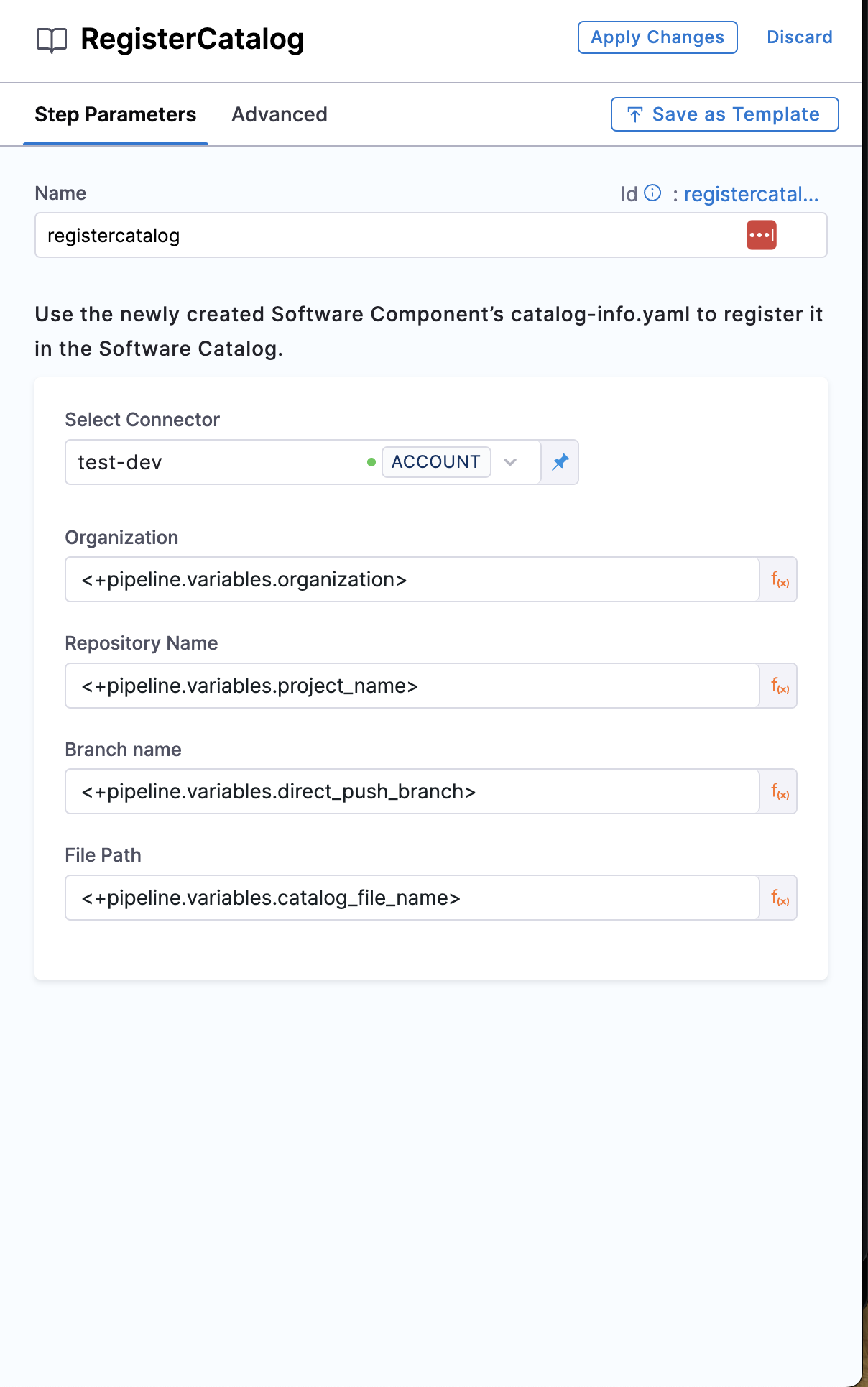
Connector
Presently for Connectors the connection type ssh is not supported and for credentials only Username and Password type is supported.


Select a connector for the git provider where your catalog-info.yaml is stored.
The following topics provide more information about creating code repo connectors:
- Azure Repos: Connect to Azure Repos
- Bitbucket: Bitbucket connector settings reference
- GitHub: GitHub connector settings reference
- GitLab: GitLab Connector Settings reference
- Other Git providers:
Org, Repo, Branch, File Path
Add the Org, Repo Name, Branch and the File path relative to the root of the repository, where your catalog-info.yaml is present.
- step:
type: RegisterCatalog
name: registercatalog
identifier: registercatalog
spec:
connectorRef: account.testdev
repository: <+pipeline.variables.project_name>
organization: <+pipeline.variables.organization>
filePath: <+pipeline.variables.catalog_file_name>
branch: <+pipeline.variables.direct_push_branch>
Following is the output variable of this step.
- catalogInfoUrl : The URL of the
catalog-info.yamlstored in your git provider where you created the repo in the CreateRepo step eg;https://github.com/org-name/repo-name/blob/code/catalog-info.yamland this variable could be used in other steps in the pipeline by using this JEXL expression as a stage variable<<+pipeline.stages.idp.spec.execution.steps.registercatalog.output.outputVariables.catalogInfoUrl>>
These output variable could be viewed under the output tab in

7. Slack Notify
This step is used to notify individual developers once the pipeline is executed successfully and your Software component is registered successfully in your Software Catalog.
In the example provided for this step we have used pipeline variables as input for many fields, make sure you have the corresponding pipeline variable created with proper value as described under pipeline variables.
- YAML
- Pipeline Studio
- step:
type: SlackNotify
name: slacknotify
identifier: slacknotify
spec:
emailId: <+pipeline.variables.email_id>
messageContent: " Hello <+pipeline.variables.project_name> project is created using flows in Harness IDP,\\n*Created Catalog Yaml -* <<+pipeline.stages.serviceonboarding.spec.execution.steps.registercatalog.output.outputVariables.catalogInfoUrl>|Link>\\n*Created Repository -* <<+pipeline.stages.serviceonboarding.spec.execution.steps.createrepo.output.outputVariables.repositoryUrl>|Link>\\n*Registered Catalog -* <<+pipeline.stages.serviceonboarding.spec.execution.steps.createcatalog.output.outputVariables.registeredCatalogUrl>|Link>"
token: slacksecrettestws
The output of the steps like Create Repo, Register Catalog in the JEXL format has been used to construct the messageContent for slack notification.
The token is the Bot-tokens
- Add the Name of the Step
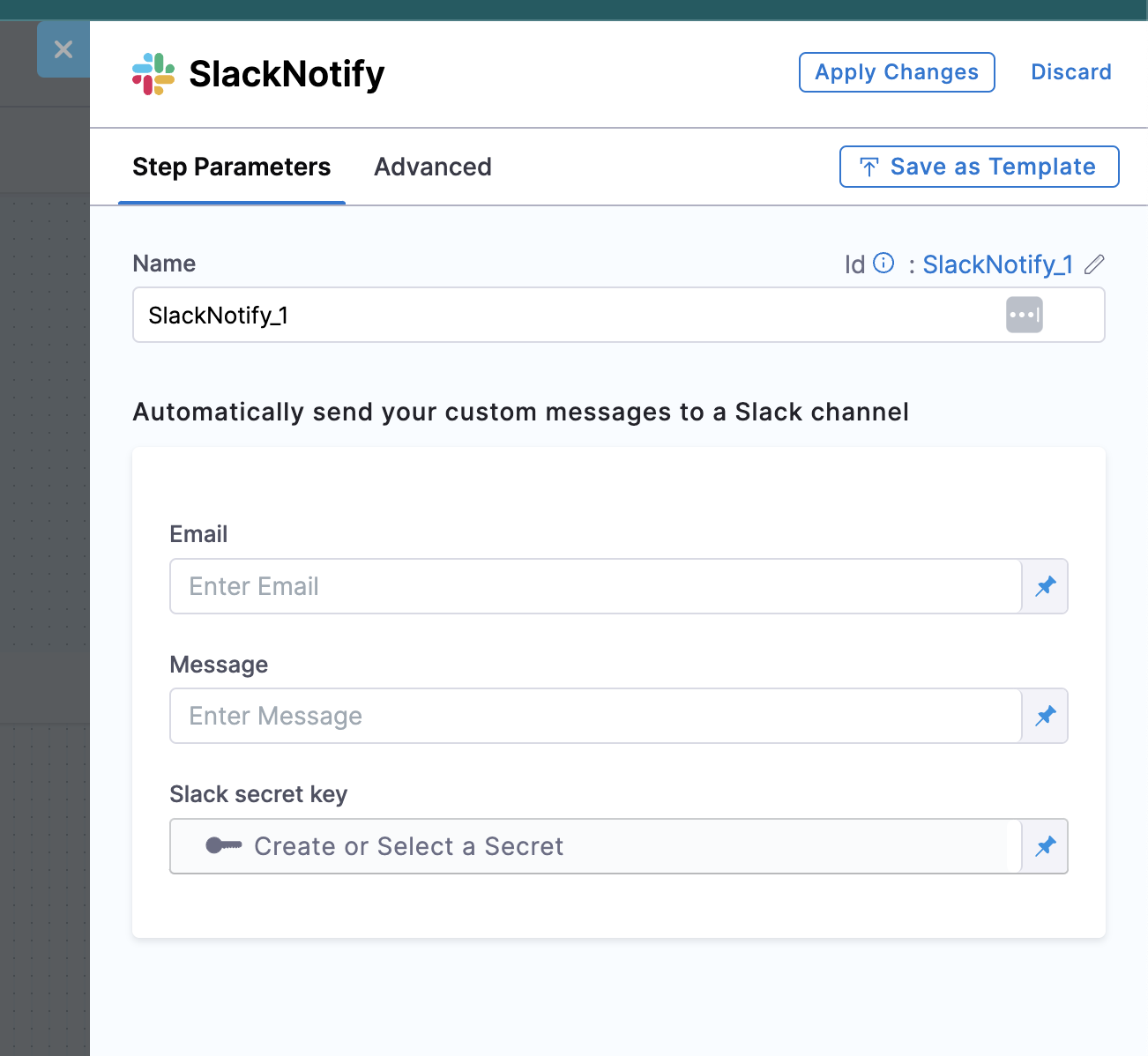
The output of the steps like Create Repo, Register Catalog in the JEXL format has been used to construct the Message for slack notification.
Slack Email ID
Use the email ID you have used to register in Slack.
Slack secret key
The Slack Secret Key are the Bot-tokens created with the following permissions.
- chat:write
- chat:write.public
- users:read.email
- users:read
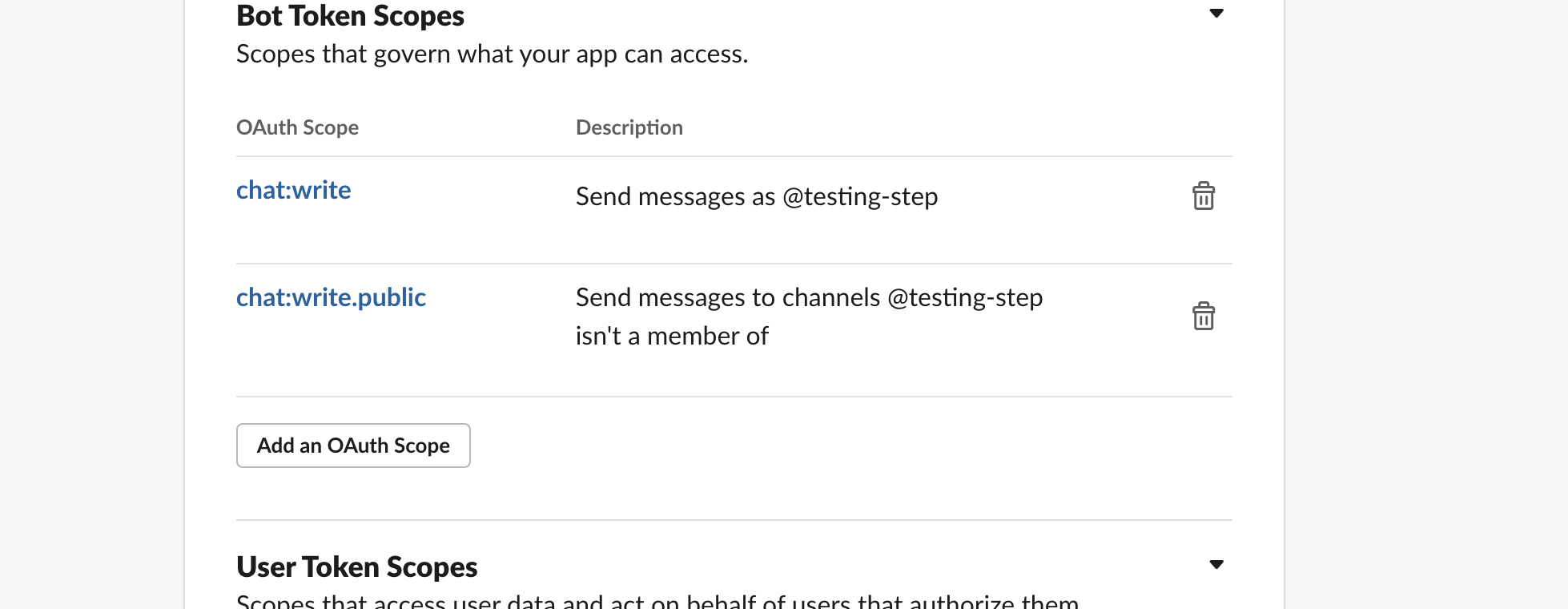
Read more on how to create bot-tokens.
- Now create a new secret and add this as a Secret under the Slack Secret Key.
Final Pipeline using Developer Portal Stage
We have been using Expression for most of the input values like <+pipeline.variables.email_id> to be able to provide these values from the templates in the form of email_id: ${{ parameters.emailid }}
Example
spec:
...
parameters:
- title: Service Details
required:
- emailid
- triggerName
properties:
emailid:
title: Enter your Email ID
type: string
description: The email ID in slack
...
...
steps:
- id: trigger
name: Creating your react app
action: trigger:harness-custom-pipeline
input:
url: ""
email_id: ${{ parameters.emailid }}
...
- YAML
- Pipeline Studio
pipeline:
name: Self-Service-flow-repo-setup
identifier: SelfServiceflowreposetup
projectIdentifier: projctidp
orgIdentifier: default
tags: {}
stages:
- stage:
name: service-onboarding
identifier: serviceonboarding
description: ""
type: IDP
spec:
infrastructure:
type: KubernetesDirect
spec:
connectorRef: idptest
namespace: harness-delegate
automountServiceAccountToken: true
nodeSelector: {}
os: Linux
execution:
steps:
- step:
type: CookieCutter
name: CookieCutter
identifier: idpcookiecutter
spec:
templateType: <+pipeline.variables.template_type>
publicTemplateUrl: <+pipeline.variables.public_template_url>
cookieCutterVariables:
app_name: <+pipeline.variables.project_name>
- step:
type: CreateRepo
name: CreateRepo
identifier: createrepo
spec:
connectorRef: account.testdev
organization: <+pipeline.variables.organization>
repository: <+pipeline.variables.project_name>
repoType: <+pipeline.variables.repository_type>
description: <+pipeline.variables.repository_description>
defaultBranch: <+pipeline.variables.repository_default_branch>
- step:
type: CreateCatalog
name: createcatalog
identifier: createcatalog
spec:
fileName: <+pipeline.variables.catalog_file_name>
filePath: <+pipeline.variables.project_name>
fileContent: |-
apiVersion: backstage.io/v1alpha1
kind: Component
metadata:
name: <+pipeline.variables.project_name>
description: <+pipeline.variables.project_name> created using self service flow
annotations:
backstage.io/techdocs-ref: dir:.
spec:
type: service
owner: test
lifecycle: experimental
- step:
type: DirectPush
name: DirectPush
identifier: directpush
spec:
connectorRef: account.testdev
repository: <+pipeline.variables.project_name>
organization: <+pipeline.variables.organization>
codeDirectory: <+pipeline.variables.project_name>
branch: <+pipeline.variables.direct_push_branch>
- step:
type: RegisterCatalog
name: registercatalog
identifier: registercatalog
spec:
connectorRef: account.testdev
repository: <+pipeline.variables.project_name>
organization: <+pipeline.variables.organization>
filePath: <+pipeline.variables.catalog_file_name>
branch: <+pipeline.variables.direct_push_branch>
- step:
type: SlackNotify
name: slacknotify
identifier: slacknotify
spec:
email: <+pipeline.variables.email_id>
messageContent: " Hello <@<+pipeline.variables.email_id>>, <+pipeline.variables.project_name> project is created using flows in Harness IDP,\\n*Created Catalog Yaml -* <<+pipeline.stages.serviceonboarding.spec.execution.steps.registercatalog.output.outputVariables.catalogInfoUrl>|Link>\\n*Created Repository -* <<+pipeline.stages.serviceonboarding.spec.execution.steps.createrepo.output.outputVariables.repositoryUrl>|Link>\\n*Registered Catlog -* <<+pipeline.stages.serviceonboarding.spec.execution.steps.createcatalog.output.outputVariables.registeredCatalogUrl>|Link>"
token: slacksecrettestws
cloneCodebase: false
caching:
enabled: false
paths: []
variables:
- name: test_content
type: String
description: ""
required: false
value: devesh
- name: project_name
type: String
description: ""
required: false
value: <+input>
- name: organization
type: String
description: ""
required: false
value: test-org-devesh
- name: template_type
type: String
description: ""
required: false
value: <+input>.default(public).allowedValues(public,private)
- name: public_template_url
type: String
description: ""
required: false
value: <+input>
- name: repository_type
type: String
description: ""
required: false
value: <+input>.default(private).allowedValues(private,public)
- name: repositoty_description
type: String
description: ""
required: false
value: <+input>
- name: repository_default_branch
type: String
description: ""
required: false
value: <+input>
- name: direct_push_branch
type: String
description: ""
required: false
value: <+input>
- name: catalog_file_name
type: String
description: ""
required: false
value: catalog-info.yaml
- name: email_id
type: String
description: ""
required: false
value: <+input>

Specify the Harness IDP images used in your pipelines
You can use the Harness IDP execution-config API to specify or update the Harness IDP images used in your infrastructure by specifying image tags.
Certain steps are common across different stages in Harness Pipeline but the images used in each of them is specific to the stage they are part of, like Run Step.
API key authentication is required. For more information about API keys, go to Manage API keys. For more information about authentication, go to the Harness API documentation.
-
Send a
get-default-configrequest to get a list of the latest Harness IDP worklfows excuted. You can use theinfraparameter to getk8images orVMimages.curl --location --request GET "https://app.harness.io/gateway/idp/execution-config/get-default-config?accountIdentifier=$YOUR_HARNESS_ACCOUNT_ID&infra=K8" \
--header 'X-API-KEY: $API_KEY'The response payload shows the latest supported images and their tags, for example:
{
"status": "SUCCESS",
"data": {
"cookieCutter": "harness/cookiecutter:1.9.1",
"createRepo": "harness/createrepo:1.9.0",
"directPush": "harness/directpush:1.9.0",
"registerCatalog": "harness/registercatalog:1.9.0",
"createCatalog": "harness/createcatalog:1.9.0",
"slackNotify": "harness/slacknotify:1.9.0",
"createOrganisation": "harness/createorganisation:1.9.0",
"createProject": "harness/createproject:1.9.0"
},
"metaData": null,
"correlationId": "08919155-a6d6-4bd3-8401-6b86318c85ca"
} -
Send a
get-customer-configrequest to get the build images that your IDP pipelines currently use. WhenoverridesOnlyistrue, which is the default value, this endpoint returns the non-default images that your pipeline uses.curl --location --request GET "https://app.harness.io/gateway/idp/execution-config/get-customer-config?accountIdentifier=$YOUR_HARNESS_ACCOUNT_ID&infra=K8&overridesOnly=true" \
--header 'X-API-KEY: $API_KEY'If the response contains
null, your pipeline is using all default images, for example:{
"status": "SUCCESS",
"data": {},
"metaData": null,
"correlationId": "11ce1bc8-b337-4687-9ab9-e13d553ae82f"
} -
Send an
update-config(POST) request with a list of the images you want to update and the new tags to apply.curl --location --request POST "https://app.harness.io/gateway/idp/execution-config/update-config?accountIdentifier=$YOUR_HARNESS_ACCOUNT_ID&infra=K8" \
--header 'X-API-KEY: $API_KEY' \
--header 'Content-Type: application/json' \
--data-raw '[
{
"field": "registerCatalog",
"value": "harness/registercatalog:1.9.0"
},
{
"field": "slackNotify",
"value": "harness/slacknotify:1.9.0"
}
]' -
To reset one or more images to their defaults, send a
reset-config(POST) request with a list of the images to reset.curl --location --request POST "https://app.harness.io/gateway/idp/execution-config/reset-config?accountIdentifier=$YOUR_HARNESS_ACCOUNT_ID&infra=K8" \
--header 'X-API-KEY: $API_KEY' \
--header 'Content-Type: application/json' \
--data-raw '[
{
"field": "registerCatalog"
},
{
"field": "createRepo"
}
]'